Fun
Hands-Free Knitting with Belts and Sheaths
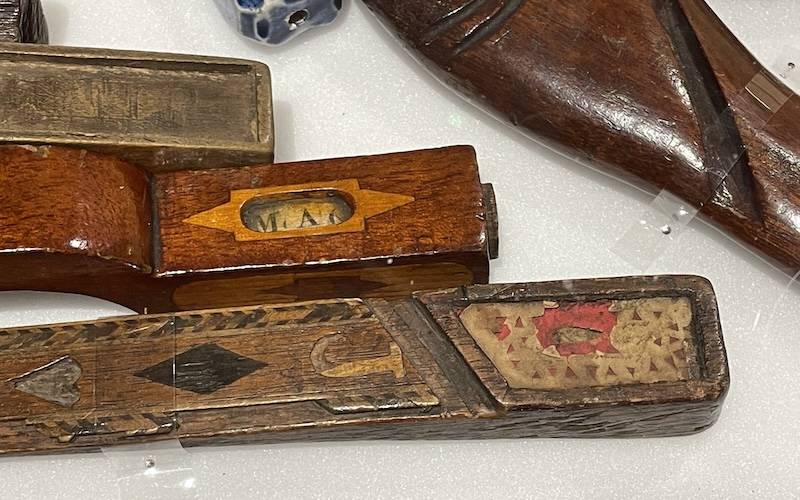
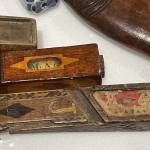
A few years ago, I asked my sister-in-law Joyce if she’d show me cable knitting. She brought over a project in progress to demonstrate and proceeded to put her right-hand needle in her armpit like a medieval jouster.
Thus began my expanded view of how needles could be held. I knew about English-versus-continental styles, but this was something different. This went to the very essence of how your needles connected to your body.
I thought perhaps pit-knitting was just a Cumbrian thing until two of my friends from opposite ends of Britain said their mothers and grandmothers also kept their “pins” in their pits.
My mind was still working on this, when I visited the Dales Countryside Museum in Hawes and I saw my first wooden knitting sticks or sheaths.

A selection of sheaths from the Dumfries and Galloway Museum, Scotland, including goose wing, twisted, and notched.
The sheaths were works of wood whittling given by suitors to sweethearts, husbands to wives, fathers and brothers to daughters and sisters. Some had little inset glass windows with inscriptions behind them. Others had puzzle chains attached to them to show the carver’s skill. Some were shaped like shoes or legs.
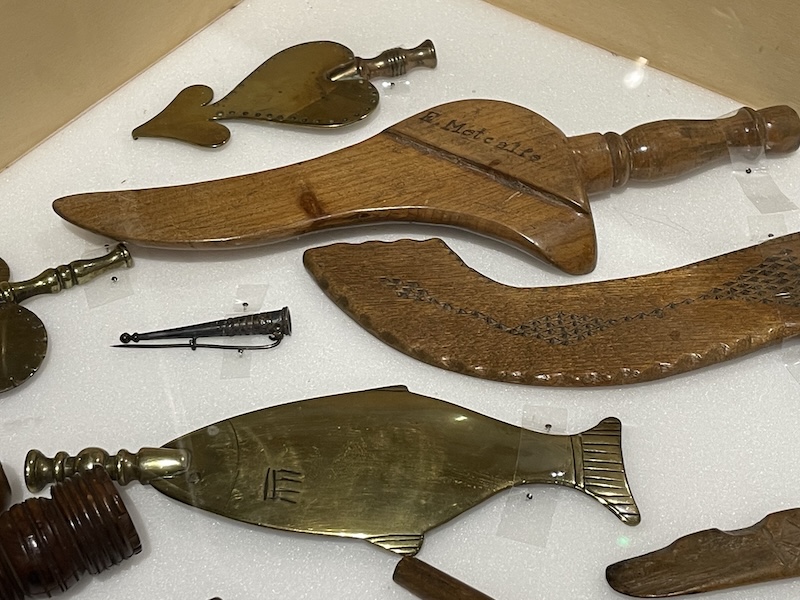
Examples of heart and fish-shaped sheaths as well as a goose-wing style. Dales Countryside Museum, Hawes.
Across Europe, sheaths were made of everything from wood to bone, silver to even glass. Regions favored a material like copper or clay based on availability. Some styles of carving proliferated in regions like a goose-wing shape in the north of England or a fish shape in Cornwall. Some Dutch examples have porcupine quills woven in a casing around them. Ultimately, wood was the most accessible and workable material.
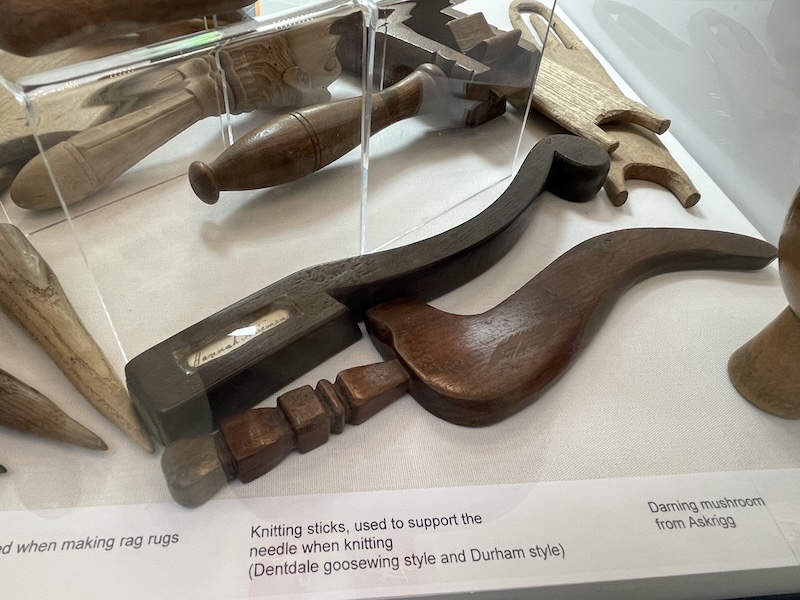
To use a sheath, the knitter wore a belt or used an apron string around their waist. The sheath was inserted between the belt and body. The stick often had a notch, carved feature, or texture that helped anchor it and kept it from slipping through the belt. There was a hole in the end of the stick and that’s where the needle went. The needles would be double pointed and sometimes curved.
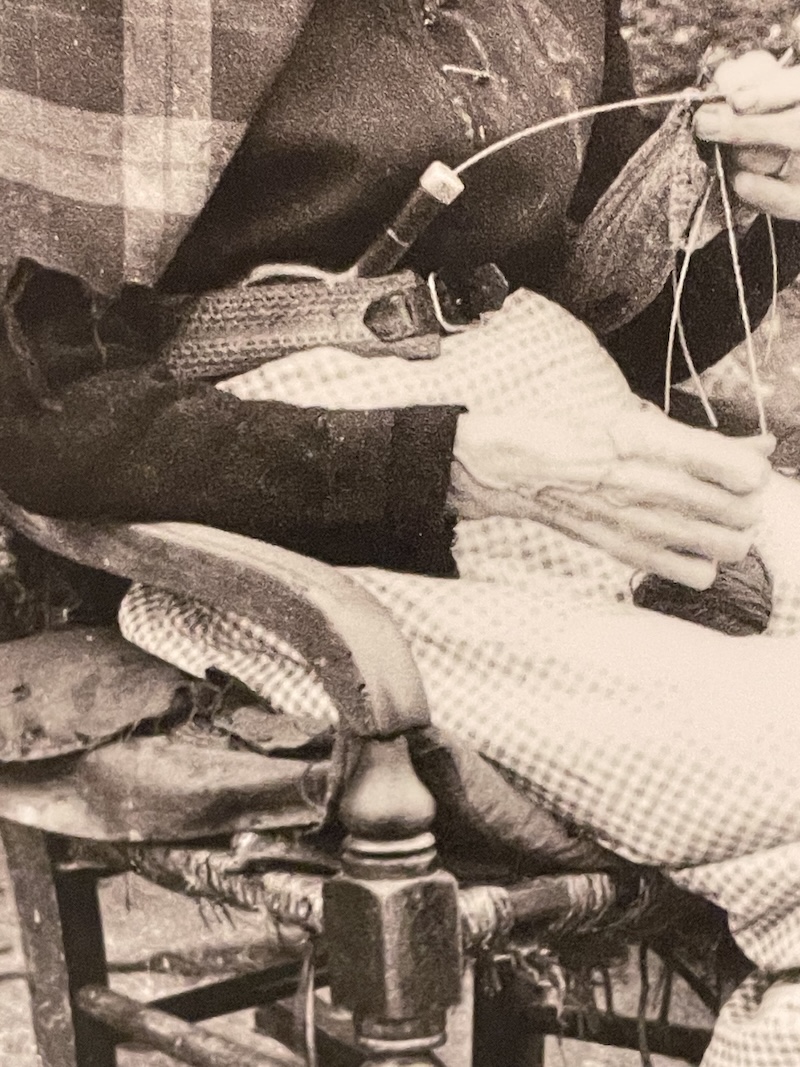
Martha Dinsdale of Appersett, Wensleydale, using a sheath. Dales Countryside Museum, Hawes.
The fact that the needles were double pointed didn’t always mean that the knitting would be in the round, it was simply the case that needles with knobs on the end were not common until the 19th century. Since a huge amount of the hand-knitting trade was in stockings and hose, knitting in the round was an essential skill. Needles were made of wire by a blacksmith or sold by a traveling peddler because there weren’t shops where you could buy needles.
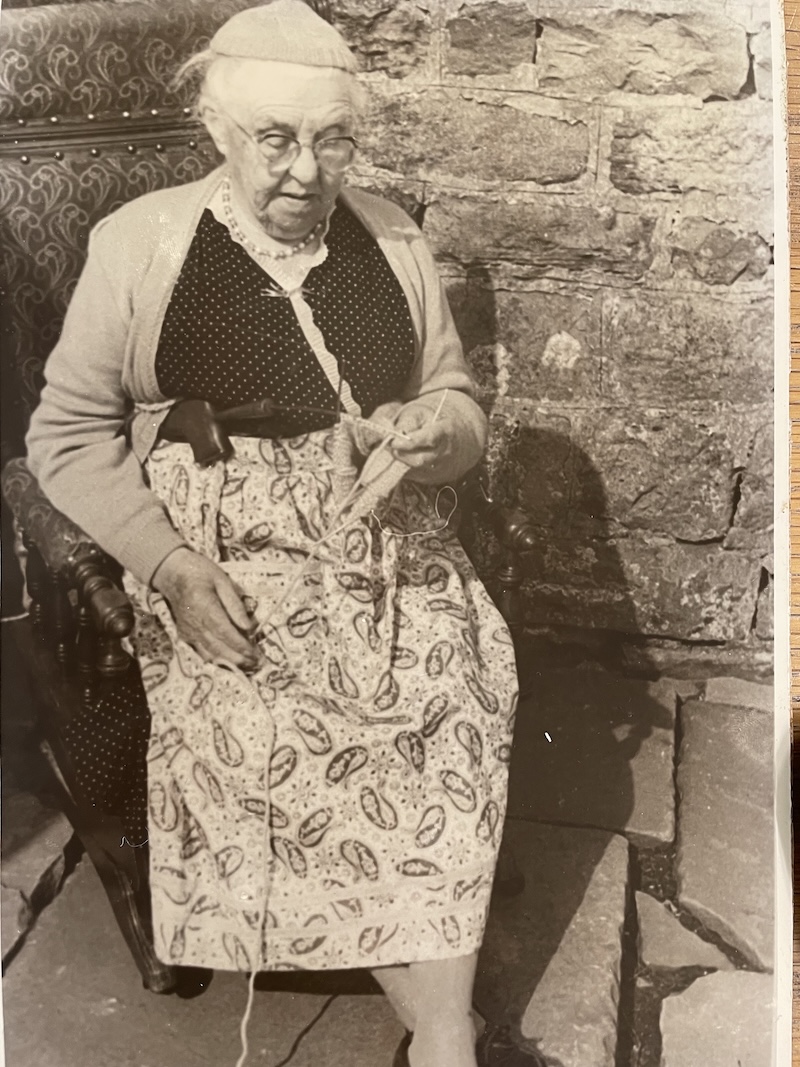
An unidentified Daleswoman using a sheath. Dales Countryside Museum, Hawes.
If you look further afield to Shetland, you’ll find their similar way of keeping the right-hand needle secure—the knitting belt. There you had an oval leather pillow filled with horsehair. One side of the pillow was punctured with holes the diameter of the needles. The pillow was either attached to a belt or inserted between a belt and the body.
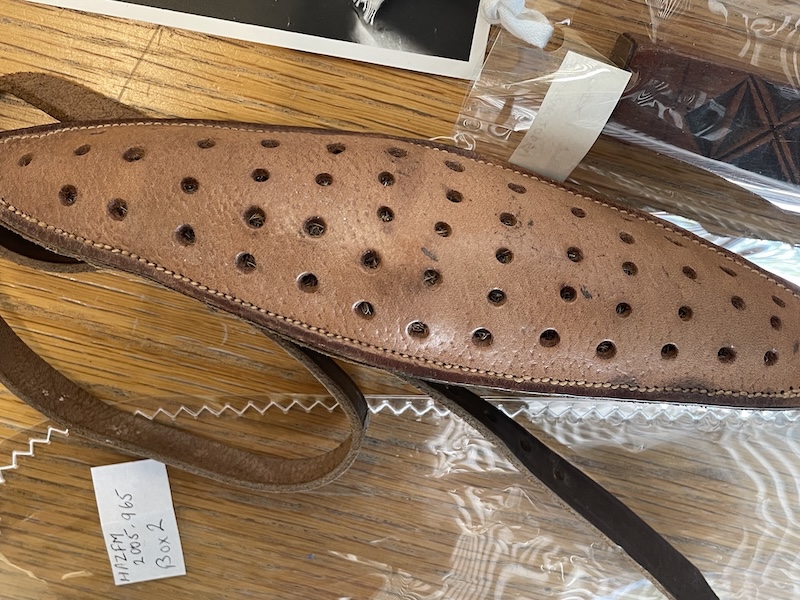
There are further variations of “sheaths” such as leather or cloth cones stuffed with straw, wooden spills, or porcupine quills which you could secure in a belt or under your arm.
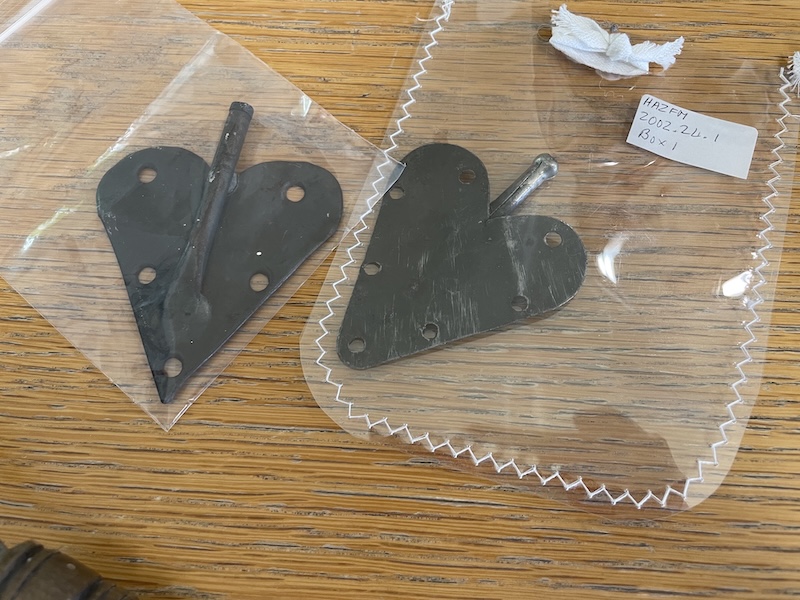
Collection of Ann Kingstone. Study day, Hawes.
One of my favorite variations are the metal hearts that would be sewn to a small pillow and then secured by apron strings or a belt. They had a knob soldered to them into which the point of the needle would go.
It’s one thing to marvel at all of these knitting needle holders and another to consider why it would be practical to have your long needle secured in a sheath, pillow, or cone at your side. And the answer, of course, is work and getting on with it at all times.

Knitting stick, 18th century, German, boxwood with silver cap. Upper part is carved with the heads of putti, beneath which are figures representing Faith, Hope, and Charity. Grooved spirally and twined around with serpents. I saw this in person by using the V&A “Order an Object” Service.
Shetland women gathered peat in baskets on the moors and then walked home with baskets on their backs. As they walked, they clicked their pins at a rapid rate. Having their knitting suspended on a needle at their side meant their hands were freer as they walked and worked. The weight of the wool was on their needle, not in their hands.
If you are pressing cheese, stoking a hearth fire, walking to trade eggs for butter in the market town, tending children, and generally managing a home without modern conveniences, your hands need to be free. But you also need to knit for your family and for extra income. So, your knitting doesn’t stay in a basket by the fire, it sits right on your hip where you can do another few rows as you wait for the bread to bake or the fire to catch.
This is not to say that knitting sticks and their cousins were only used by working women. There are exquisite examples of knitting sticks used by privileged ladies who held their needles in the same manner as those in humble cottages.
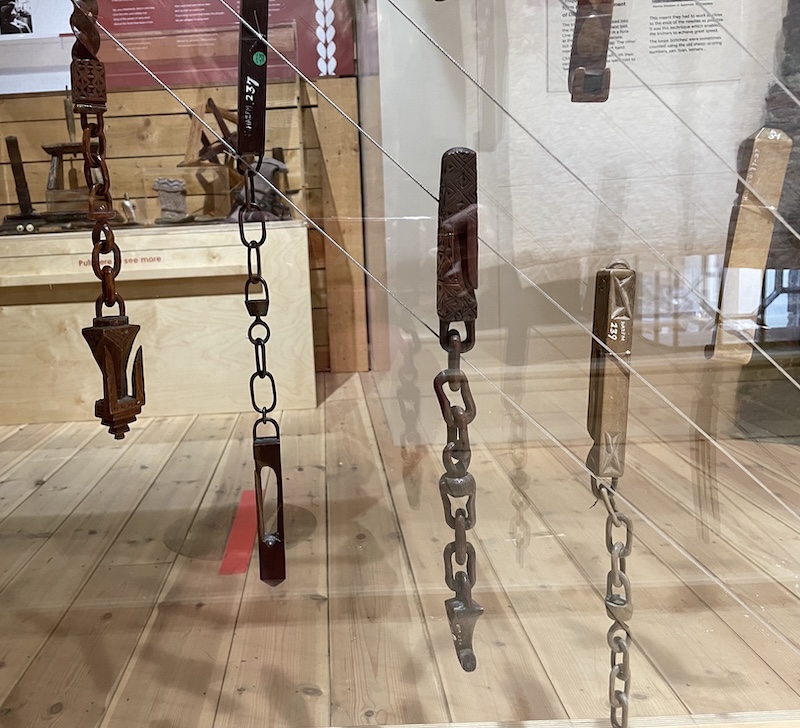
Some knitting sticks had wooden chains with hooks at the end onto which a ball of wood could be fastened. Dales Countryside Museum, Hawes.
By now you might be wondering “Where was the ball of yarn while these knitting sticks were used?” That is a tale for another time.


I had a friend many years ago who had a disability that caused her to be unable to move her right arm. She held her right knitting needle in her armpit. I was impressed seeing her knit that way, I’d never seen anyone else do that. Human ingenuity and resourcefulness is amazing.
I really want to know “the rest of the story”. I can’t help picturing the ball of yarn falling out of an apron pocket into the fire. Maybe a button to keep the pocket closed?
Thank you for this review. Hope you or someone else will expand and show how that knitting was actually done with a needle that is stationary (be it in an arm pit or in a holder on the waist). Is it more time efficient? Inquiring minds want to know. LOL.
Hi there Robyn, here’s a great video showing the technique!
https://www.youtube.com/watch?v=2c-M37brGx8
Fascinating. Your article was a real eye-opener. I guess necessity really is the mother of invention.
Thanks for sharing this vid. Saw the Shetland style but somehow missed this in my YT search.
This is fascinating! Thank you! I had no idea!!
When I was 8 years old & learning to knit, I was too little* to hold the needles & the weight of the worsted weight yarn so I started using a “weird, not elegant like your Mom” method that worked for little itty bitty me! I held my “left hand needle” between my knees, basically duplicating this armpit method but more in front of my itty bitty eyes & other hand! I kept using this technique until I discovered the glorious new invention of interchangeable circular needles. So many times I had people try to tell me I was “doing it wrong” so I held up my finished fabric & asked them “What’s wrong with this? Tell me”!
They never had an answer…
They always stopped their criticism!
*I was the youngest of 3 & always small for my age. There’s a family legend of our OB/Pediatrician saying to Mom in the delivery room at my birth, “Oh! This must be the runt of the litter!” Mom was not impressed, but she laughed all the same. We all still do!
Fascinating. I have MS and it affects my hands. This ‘old fashioned’ method of knitting could make knitting accessible to people with difficulties with their fine motor skills.
I love this story so much. Thank you for writing about itty bitty you and the fact that there are so many ways to knit. Wonderful!!
This week I’m so busy I have barely had time to sit let alone knit A row or two. These contraptions would have come in handy!
I am very tempted to start knitting while I walk. Just doing something simple at first to train my hands and then going from there. I think I would walk a lot more if I knitted at the same time!
It is totally possible to knit while you walk! Mind you, you won’t be speed walking nor knitting anything where you
need to reference the pattern a lot. I have a hat I knit wandering around antique stores for two days. And I’ve taken vanilla socks into stores when I’m with people who like to wander through them (I’m terrible at browsing). Have a wrist loop on your project bag to help hold your yarn and such.
The mini minders from Lemon wood are good for holding your knitting while you walk!
I still will knit with a straight needle between my legs for a large project like a lap robe. It’s better for me than trying to hold up the weight of the project with my left hand. I had been taught to knit when I was 4 and discovered my legs helped me just fine. LOL
Wish you had a video of this style. Would love to see it as I’m more visual than cerebral. BTW I’ve learned knitting thru YouTube.
I love knowing that, Karen! I love that my knowledge of how people hold their needles keeps expanding!
I learned to knit that way from one of my first knitting books, A Handknitter’s Handbook by Montse Stanley. Nowadays I mostly use circulars, but when I do use straight needles the right one is in my pit. It gave me so much more control, especially when I was first learning, and is much easier on the wrists.
I agree about the wrists. My wrists don’t seem to be able to cope with anything over a 4mm needle and matching wool weight, so I am thinking of switching to this technique for wrist relief.
Thanks for this beautifully written piece right down to the sneaky cliffhanger ending. I usually gloss over the technical parts (too much concentration!) but your writing style is so fluid that it slid me over the “boring” parts and I didn’t even know it. Looking forward to the whereabouts of that yarn!
That’s such a great compliment, Chloe! Thank you!
Fascinating article with incredible pictures, thank you very much. Can’t wait to find out more!
Thank you, Ann. I’ve posted a comment with links and resources if you want to learn more!
A young neighbor taught me to knit in Scotland when I lived there as a newlywed for a year. Right needle held by the armpit. That’s still how I do it. Circulars just don’t feel quite as comfortable.
I love that story!
I would love to see a demo of how to use some of these things. The multi-tasking is very impressive! My knitting style is anything but elegant, but that doesn’t seem to detract from the pleasure I take from the craft!
Hi Arlene, here is a link to a video which shows the sheath technique demonstrated by Elizabeth Lovick:
https://www.youtube.com/watch?v=2c-M37brGx8
Hi all, thank you for so many positive and informative comments on my article! I love hearing about all of the ways that you and people you know have learned to knit or adapted knitting using similar techniques and tools as sheath, pit, belt, and porcupine quill knitters.
Here are some further resources including a link to a video which shows the sheath technique demonstrated by Elizabeth Lovick:
https://www.youtube.com/watch?v=2c-M37brGx8
Knitting Sticks and Sheaths: A History by the late Dr Ian McFeeters. Bleasdales Press. A comprehensive guide with extensive photos. He provides a thorough list of where sticks can be seen in museums and collections across Europe.
Susan Webster in Australia keeps a website full of comprehensive examples and history of knitting tools including knitting sheaths.
https://knitting-needle-notions.com.au/articles-and-presentations/
I have grown up using this method. I like the fact that with straight needles the stitches are a consistent size.
I do also use dps and knitpros circular sets.
As a child, I used a knitting belt with the yarn in a bag this enabled me to knitting whilst walking
Jeni, so very interesting and thanks for including links to videos in so many of the responses! Can’t wait for more “yarns”! Why were the “balls”eventually added to the yarn “sticks”…I could google that but more fun to learn here!!! Take care!
The sheaths and other tools are so beautiful! That shows an appreciation for the craft, I would think.
I’m not sure that I can (or should) walk and knit at the same time! But I’d love to try with some of these gorgeous tools.
I LOVE reading your columns. It is always something new and fascinating. I am looking forward to watching the video. I knew this existed, but never knew that much about it. Thank you so much for this sharing your research.
Amazing article. I’ve learnt something today, but I’ve never learnt to knit.
Looking forward to the next story
I had a friend who was from Lebanon and grew up during the war. Even here in the states, she would knit while she made yogurt with the right arm method in play. So ingenuous.
Who knew?! Not me! Thank you! 🙂
Thanks for the article. I’ve never heard of knitting sheaths, let alone with chains and hooks on them. Neato! The carvings are so awesome!
I’m thinking of whittling my own, but I’d like to understand it better first. I can’t quite picture how the chain/hook part is used. I can find video/pics of the sheath being used but not the chain/hook or “clew-holder”, as one website called it, I think? They mention that it holds the “weight of the work”. Does this mean you hook your project on it? I was thinking I’d shove the hook through my ball of yarn and let it dangle, haha, but then it’d unwind while walking. What’s the truth of it? TIA!
I visited the Dales Museum a couple of years ago and found the knitting sheaths fascinating. Some of my ancestors were kead miners and farmers in Swaledale and I have no doubt that they would have used them.
My grandmother was from Leeds and she used to knit in the 60s and 70s with one needle in her armpit and often the ball of wool in an apron pocket so she could ‘knit on the go’.
That was very interesting as I’ve been ‘armpit’ knitting for years, I find it a lot faster than holding the needles in both hands, I’m a lot slower knitting with circular needles & so many patterns nowadays are neck down! Unfortunately I’ve been trying lots of knitting styles as after having a mastectomy on my right hand side the needle irritates my scar. I’ve been toying with making a cushion to put the needle in and be comfortable knitting fast again.
I also found people watching me ‘pit knitting’ & the speed I go 🙂
Maybe a knitting belt would work for you. You might need to experiment a bit since I think the angle would be different.
This is fascinating, Jeni! I had no idea.
Very interesting I still can’t understand. I started knitting when I was 10 and still knitting at 79 I love it. I sometimes crochet but knitting is my love. Thanks for sharing part of history
Love the article and photos, I would be very interested if you have more photos from your research. I’m currently trying to research the origins of different styles of knitting sheaths in order to write a reference book on them. I have just inherited my dads collection of knitting sheaths. Any information would be greatly appreciate.I have the book of Dr Mcfeetors as well as some of his sheaths when he passed away. Along with several books.
Very wonderful informative article! We knitters really have it easy today!!!!
I’m another “unconventional” knitter. Some self-righteous woman once told me (with her nose in the air) that I knitted “like a Mexican woman on a bus.” She thought I’d be insulted. I took it as a compliment, knowing some Mexican child would probably be kept warm by a sweater his mother made for him.
Fascinating!
I have grown up using this method. I like the fact that with straight needles the stitches are a consistent size.
I do also use dps and knitpros circular sets.
As a child, I used a knitting belt with the yarn in a bag this enabled me to knitting whilst walking
Love artifacts! Thank you for this practical history lesson.
Thank you for the story/information. I am left handed and when my right handed mom attempted to teach me to knit (when I was 8 years old), I could not hold the needles. I learned that while sitting, I could anchor the right knitting needle into my hip/leg joint. If the needle is double pointed I use a needle protector on the end of the right knitting needle. I have heard numerous times how awkward it looks, but I have made many beautiful things with this method over my 50 years with the craft. I can see the value of a knitting stick!
How fascinating. I’d like to see someone actually using these knitting implements – they look so awkward!
Absolutely amazing and such an industrious use of something we in modern times see as more of a hobby.
Thank you for this historical knowledge.
Hello! I would really love to be able to read your article on Hands Free Knitting with Belts and Sheaths but alas, the red text against the black background is unreadable to me.
Could uounreconsider an alternative color combination?
Best wishes and congratulations on your publication.
Gloria from Santa Clarita, California, USA
In the world of strange coincidence, I watched Antiques Roadshow UK last night (from SC, USA) and there was a beautifully carved wood knitting sheath dated 1747. The expert was thrilled to see it, and so was I! If not for reading your article on the same day, I would not have known what it was nor how it was used. Thank you, Jeni!
So interesting! This answers my questions I had on this knitting skill. Thanks
Kathleen
What fun to see all these items! I first saw ‘armpit knitting’ by a woman from Argentina. Her fingers flew!
I had heard of knitting belts so I was quite interested in the knitting sticks. It is quite a lot of enjoyment to learn something new about by favorite craft, even at 79 years.
The first interesting piece of google news I’ve ever read.
Very interesting. Thank you for sharing.
I think the caption on the last photo has a typo, and should say “… wooden chains with hooks at the ends onto which a ball of wool could be fastened.” Wool, not wood!
Ok, having a hard time wrapping my head around this
Any possibility of a video??
Thanks for sharing this essay and pics. Had no idea of the “sticks” in various designs.
I think t
hey are so beautiful.i find it hard to understand how these fairisle knitters coped!
I find it difficult enough using a pair of knitting needles !!
I had occasion to attend a book tour gathering near Seattle for Debbie Stoller some years ago. While she was talking about her then-newest book and showing samples of the book patterns, she knit a bit as she talked and was knitting with one needle under her arm. So fascinating!!
Thank you for the article, do you have any other photos or information on them? I’m currently research knitting sheaths in order to write a reference book on them, as I have inherited my dads collection.